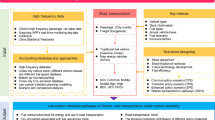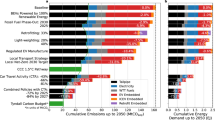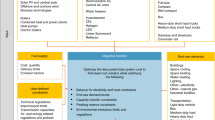Abstract
Transport is a major contributor to carbon emissions and air pollution in China. Ongoing urbanization provides a unique opportunity for Chinese cities to abate emissions by reducing transport demand via compact urban development (CUD). Here we systematically evaluate the implications of CUD for climate, energy use, air quality and human health in 2050 China under various scenarios of alternative energy vehicle (AEV) deployment and power decarbonization. We find that, with low AEV penetration and carbon intensive power (57% coal + gas), ambitious CUD policy reduces on-road transport CO2 and NOx emissions by 97 Mt (8%) and 95 kt (7%), respectively, and avoids 25,000 premature deaths from ambient air pollution in 2050. CUD delivers less climate and air quality co-benefits as AEV penetration increases and their energy sources decarbonize, but continues to reduce vehicle energy use (up to 10%). With 100% AEV penetration, ambitious CUD policy still avoids 5,800 premature deaths by reducing non-exhaust vehicle emissions and upstream emissions. Our analysis demonstrates that CUD policy would provide considerable environmental and economic benefits in China.
This is a preview of subscription content, access via your institution
Access options
Access Nature and 54 other Nature Portfolio journals
Get Nature+, our best-value online-access subscription
$29.99 / 30 days
cancel any time
Subscribe to this journal
Receive 12 digital issues and online access to articles
$119.00 per year
only $9.92 per issue
Buy this article
- Purchase on Springer Link
- Instant access to full article PDF
Prices may be subject to local taxes which are calculated during checkout





Similar content being viewed by others
Data availability
The Dynamic Projection model for Emissions in China (DPEC) emission inventory is available from the MEIC website (http://meicmodel.org.cn/?page_id=1917, registration required). WRF-Chem outputs and data generated in this study are publicly available on the Princeton archive at https://doi.org/10.34770/njry-v825. Data for the meta-analysis and the evaluations of health impacts and economic benefits were collected from literature and reports which are listed in the Methods and Supplementary Information. The CMIP6 emissions database is available at https://esgf-node.llnl.gov/search/input4mips/. The ECLIPSE emissions database is available at https://previous.iiasa.ac.at/web/home/research/researchPrograms/air/Global_emissions.html. The Global Burden of Disease database is available at http://ghdx.healthdata.org/. The SSP database is available at https://tntcat.iiasa.ac.at/SspDb/dsd?Action=htmlpage&page=10. The Annual Technology Baseline database is available at https://atb.nrel.gov/electricity/2021/index.
Code availability
Source codes of the WRF-Chem model utilized in this study are available at https://github.com/wrf-model/WRF/releases/tag/V3.6.1. The codes developed for data analysis in this study are available on the Princeton archive at https://doi.org/10.34770/njry-v825.
References
Masson-Delmotte, V. et al. (eds) Climate Change 2021: The Physical Science Basis (Cambridge Univ. Press, 2021).
Creutzig, F. et al. Transport: a roadblock to climate change mitigation? Science 350, 911–912 (2015).
Peng, L. et al. Alternative-energy-vehicles deployment delivers climate, air quality, and health co-benefits when coupled with decarbonizing power generation in China. One Earth 4, 1127–1140 (2021).
Knobloch, F. et al. Net emission reductions from electric cars and heat pumps in 59 world regions over time. Nat. Sustain. 3, 437–447 (2020).
Liang, X. et al. Air quality and health benefits from fleet electrification in China. Nat. Sustain. 2, 962–971 (2019).
Xing, J. et al. The quest for improved air quality may push China to continue its CO2 reduction beyond the Paris Commitment. Proc. Natl Acad. Sci. USA 117, 29535–29542 (2020).
Zhang, F. et al. Estimation of abatement potentials and costs of air pollution emissions in China. J. Environ. Manage. 260, 110069 (2020).
Creutzig, F. et al. Demand-side solutions to climate change mitigation consistent with high levels of well-being. Nat. Clim. Change https://doi.org/10.1038/s41558-021-01219-y (2021)
Creutzig, F. et al. Towards demand-side solutions for mitigating climate change. Nat. Clim. Change 8, 260–263 (2018).
Axsen, J., Plötz, P. & Wolinetz, M. Crafting strong, integrated policy mixes for deep CO2 mitigation in road transport. Nat. Clim. Change 10, 809–818 (2020).
Global platform for sustainable cities. A Review of Integrated Urban Planning Tools for Greenhouse Gas Mitigation https://www.thegpsc.org/knowledge-products/integrated-urban-planning/review-integrated-urban-planning-tools-greenhouse-gas (2020).
Ewing, R. & Cervero, R. Travel and the built environment: a meta-analysis. J. Am. Plann. Assoc. 76, 265–294 (2010).
Næss, P., Cao, J. & Strand, A. Which D’s are the important ones? The effects of regional location and density on driving distance in Oslo and Stavanger. J. Transp. Land Use https://doi.org/10.5198/jtlu.2017.1183 (2017).
Cervero, R. & Kockelman, K. Travel demand and the 3Ds: density, diversity, and design. Transp. Res. D 2, 199–219 (1997).
Cervero, R. & Murakami, J. Effects of built environments on vehicle miles traveled: evidence from 370 US urbanized areas. Environ. Plan. A 42, 400–418 (2010).
Newman, P. W. G. & Kenworthy, J. R. Gasoline consumption and cities. J. Am. Plann. Assoc. 55, 24–37 (1989).
Fu, X., Mauzerall, D. L. & Ramaswami, A. Public and private transportation in Chinese cities: impacts of population size, city wealth, urban typology, the built environment, and fuel price. Environ. Res. Infrastruct. Sustain. 3, 021001 (2023).
Li, L. et al. Mitigation of China’s carbon neutrality to global warming. Nat. Commun. 13, 5315 (2022).
Zheng, B. et al. Trends in China’s anthropogenic emissions since 2010 as the consequence of clean air actions. Atmos. Chem. Phys. 18, 14095–14111 (2018).
Wang, H. et al. Health benefits of on-road transportation pollution control programs in China. Proc. Natl Acad. Sci. USA 117, 25370–25377 (2020).
Burnett, R. et al. Global estimates of mortality associated with long-term exposure to outdoor fine particulate matter. Proc. Natl Acad. Sci. USA 115, 9592–9597 (2018).
Turner, M. C. et al. Long-term ozone exposure and mortality in a large prospective study. Am. J. Respir. Crit. Care Med. 193, 1134–1142 (2016).
State Council of the People’s Republic of China. Long-Range Objectives Through the Year 2035 (2021).
Chen, W. et al. Carbon neutrality of China’s passenger car sector requires coordinated short-term behavioral changes and long-term technological solutions. One Earth 5, 875–891 (2022).
Zhang, R. & Hanaoka, T. Cross-cutting scenarios and strategies for designing decarbonization pathways in the transport sector toward carbon neutrality. Nat. Commun. 13, 3629 (2022).
Thunis, P. et al. Non-linear response of PM2.5 to changes in NOx and NH3 emissions in the Po basin (Italy): consequences for air quality plans. Atmos. Chem. Phys. 21, 9309–9327 (2021).
China Association of Automobile Manufacturers. Number of Cars in China in 2022 http://www.caam.org.cn/chn/11/cate_120/con_5235744.html (2022).
Lu, Q. et al. Decarbonization scenarios and carbon reduction potential for China’s road transportation by 2060. npj Urban Sustain. 2, 34 (2022).
Wang, H. et al. China’s electric vehicle and climate ambitions jeopardized by surging critical material prices. Nat. Commun. 14, 1246 (2023).
Güneralp, B., Reba, M., Hales, B. U., Wentz, E. A. & Seto, K. C. Trends in urban land expansion, density, and land transitions from 1970 to 2010: a global synthesis. Environ. Res. Lett. 15, 044015 (2020).
Wagner, F. et al. Using explainable machine learning to understand how urban form shapes sustainable mobility. Transp. Res. D 111, 103442 (2022).
IEA The Role of Critical Minerals in Clean Energy Transitions https://www.iea.org/reports/the-role-of-critical-minerals-in-clean-energy-transitions (2021).
Sayed, E. T. et al. A critical review on environmental impacts of renewable energy systems and mitigation strategies: wind, hydro, biomass and geothermal. Sci. Total Environ. 766, 144505 (2021).
Tawalbeh, M. et al. Environmental impacts of solar photovoltaic systems: a critical review of recent progress and future outlook. Sci. Total Environ. 759, 143528 (2021).
Güneralp, B. et al. Global scenarios of urban density and its impacts on building energy use through 2050. Proc. Natl Acad. Sci. USA https://doi.org/10.1073/pnas.1606035114 (2017).
Javaid, A., Creutzig, F. & Bamberg, S. Determinants of low-carbon transport mode adoption: systematic review of reviews. Environ. Res. Lett. 15, 103002 (2020).
Green Travel Action Plan (2019–2022) (Ministry of Transport of China, 2019).
Hong, C. et al. Impacts of climate change on future air quality and human health in China. Proc. Natl Acad. Sci. USA 116, 17193–17200 (2019).
Liu, L. et al. Health and climate impacts of future United States land freight modelled with global-to-urban models. Nat. Sustain. 2, 105–112 (2019).
Yang, H., Huang, X., Westervelt, D. M., Horowitz, L. & Peng, W. Socio-demographic factors shaping the future global health burden from air pollution. Nat. Sustain. 6, 58–68 (2023).
Anita, W. M., Ueda, K., Uttajug, A., Seposo, X. T. & Takano, H. Association between long-term ambient PM2.5 exposure and under-5 mortality: a scoping review. Int. J. Environ. Res. Public Health 20, 3270 (2023).
Woodruff, T. J., Darrow, L. A. & Parker, J. D. Air pollution and postneonatal infant mortality in the United States, 1999–2002. Environ. Health Perspect. 116, 110–115 (2008).
Urban China: Toward Efficient, Inclusive, and Sustainable Urbanization (World Bank and Development Research Center of the State Council, P. R. C., 2014).
Wang, D. & Zhou, M. The built environment and travel behavior in urban China: a literature review. Transp. Res. D 52, 574–585 (2017).
Salon, D., Boarnet, M. G. & Mokhtarian, P. Quantifying the Effect of Local Government Actions on VMT (California Air Resources Board and California Environmental Protection Agency, 2014).
Næss, P. Urban form, sustainability and health: the case of Greater Oslo. Eur. Plan. Stud. 22, 1524–1543 (2014).
Tong, D. et al. Dynamic projection of anthropogenic emissions in China: methodology and 2015–2050 emission pathways under a range of socio-economic, climate policy, and pollution control scenarios. Atmos. Chem. Phys. 20, 5729–5757 (2020).
Fussell, J. C. et al. A review of road traffic-derived non-exhaust particles: emissions, physicochemical characteristics, health risks, and mitigation measures. Environ. Sci. Technol. 56, 6813–6835 (2022).
Beddows, D. C. S. & Harrison, R. M. PM10 and PM2.5 emission factors for non-exhaust particles from road vehicles: dependence upon vehicle mass and implications for battery electric vehicles. Atmos. Environ. 244, 117886 (2021).
Liu, Y. et al. Exhaust and non-exhaust emissions from conventional and electric vehicles: a comparison of monetary impact values. J. Clean. Prod. 331, 129965 (2022).
Chen, Y. et al. Provincial and gridded population projection for China under shared socioeconomic pathways from 2010 to 2100. Sci. Data 7, 83 (2020).
Zhou, Y., Varquez, A. C. G. & Kanda, M. High-resolution global urban growth projection based on multiple applications of the SLEUTH urban growth model. Sci. Data 6, 34 (2019).
Zheng, B. et al. High-resolution mapping of vehicle emissions in China in 2008. Atmos. Chem. Phys. 14, 9787–9805 (2014).
Cheng, J. et al. Pathways of China’s PM2.5 air quality 2015–2060 in the context of carbon neutrality. Natl Sci. Rev. 8, nwab078 (2021).
Moody, J., Wang, S., Chun, J., Ni, X. & Zhao, J. Transportation policy profiles of Chinese city clusters: a mixed methods approach.Transp. Res. Interdiscip. Perspect. 2, 100053 (2019).
Ueckerdt, F. et al. Potential and risks of hydrogen-based e-fuels in climate change mitigation. Nat. Clim. Change 11, 384–393 (2021).
Nykvist, B. & Olsson, O. The feasibility of heavy battery electric trucks. Joule 5, 901–913 (2021).
Grell, G. A. et al. Fully coupled ‘online’ chemistry within the WRF model. Atmos. Environ. 39, 6957–6975 (2005).
Gidden, M. J. et al. Global emissions pathways under different socioeconomic scenarios for use in CMIP6: a dataset of harmonized emissions trajectories through the end of the century. Geosci. Model Dev. 12, 1443–1475 (2019).
Klimont, Z. et al. Global anthropogenic emissions of particulate matter including black carbon. Atmos. Chem. Phys. 17, 8681–8723 (2017).
Chen, D., Liu, Z., Fast, J. & Ban, J. Simulations of sulfate–nitrate–ammonium (SNA) aerosols during the extreme haze events over northern China in October 2014. Atmos. Chem. Phys. 16, 10707–10724 (2016).
Zhou, M. et al. Environmental benefits and household costs of clean heating options in northern China. Nat. Sustain. 5, 329–338 (2022).
Tang, R. et al. Air quality and health co-benefits of China’s carbon dioxide emissions peaking before 2030. Nat. Commun. 13, 1008 (2022).
Yang, J., Zhao, Y., Cao, J. & Nielsen, C. P. Co-benefits of carbon and pollution control policies on air quality and health till 2030 in China. Environ. Int. 152, 106482 (2021).
Geng, G. et al. Drivers of PM2.5 air pollution deaths in China 2002–2017. Nat. Geosci. 14, 645–650 (2021).
Nielsen, C. P., Ho, M. S. & Jorgenson, D. W. Clearer Skies over China: Reconciling Air Quality, Climate, and Economic Goals (MIT Press, 2013).
He, J. & Wang, H. The Value of Statistical Life: A Contingent Investigation in China (The World Bank, 2010).
Xie, X. The Value of Health: Method for Environmental Impact Assessment and Strategies for Urban Air Pollution Control. PhD thesis, Peking University, 2011.
Riahi, K. et al. The Shared Socioeconomic Pathways and their energy, land use, and greenhouse gas emissions implications: an overview. Glob. Environ. Change 42, 153–168 (2017).
Li, M. et al. Air quality co-benefits of carbon pricing in China. Nat. Clim. Change 8, 398–403 (2018).
IEA. CCUS in Clean Energy Transitions https://www.iea.org/reports/ccus-in-clean-energy-transitions (2020).
Acknowledgements
We thank A. Ramaswami for advice on the meta-analysis of CUD literature and city categorization; S. Liu, Y. Wu and Y. Xie for advice on model simulations and the evaluation of co-benefits. We acknowledge funding from the Princeton School of Public and International Affairs and the Prize Fellowship in the Social Sciences at Princeton University for graduate fellowship support for X.F., and the National Natural Science Foundation of China (72140003 and 72243008) for supporting D.T.
Author information
Authors and Affiliations
Contributions
X.F., D.T. and D.L.M. conceived the research idea and designed the study; X.F. conducted the meta-analysis, designed the scenarios, and conducted air pollution simulations and health calculations; J.C. and D.T. conducted emission simulations; L.P. and M.Z. contributed to air quality simulations and health calculations; X.F. and D.L.M. wrote the paper with contributions from all authors.
Corresponding authors
Ethics declarations
Competing interests
The authors declare no competing interests.
Peer review
Peer review information
Nature Sustainability thanks Felix Creutzig, Bumsoo Lee and the other, anonymous, reviewer(s) for their contribution to the peer review of this work.
Additional information
Publisher’s note Springer Nature remains neutral with regard to jurisdictional claims in published maps and institutional affiliations.
Supplementary information
Supplementary Information
Supplementary Notes 1–5, Figs. 1–18 and Tables 1–21.
Rights and permissions
Springer Nature or its licensor (e.g. a society or other partner) holds exclusive rights to this article under a publishing agreement with the author(s) or other rightsholder(s); author self-archiving of the accepted manuscript version of this article is solely governed by the terms of such publishing agreement and applicable law.
About this article
Cite this article
Fu, X., Cheng, J., Peng, L. et al. Co-benefits of transport demand reductions from compact urban development in Chinese cities. Nat Sustain 7, 294–304 (2024). https://doi.org/10.1038/s41893-024-01271-4
Received:
Accepted:
Published:
Issue Date:
DOI: https://doi.org/10.1038/s41893-024-01271-4



